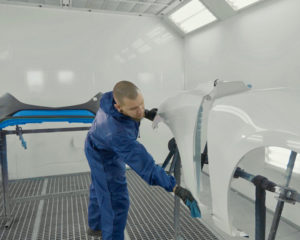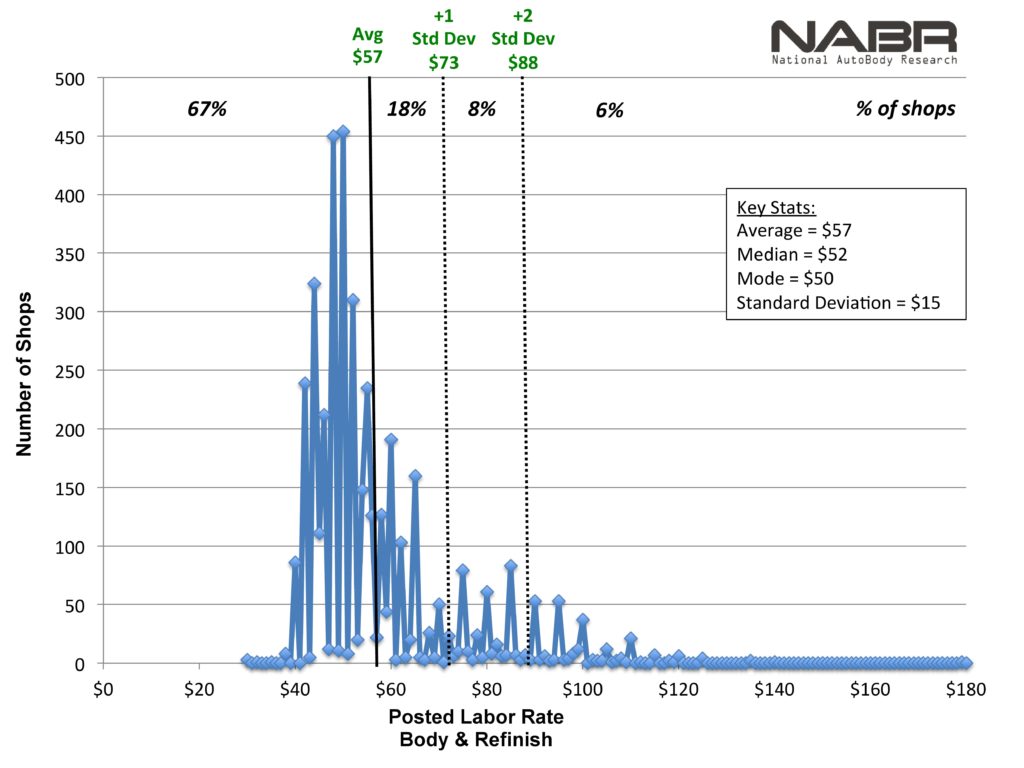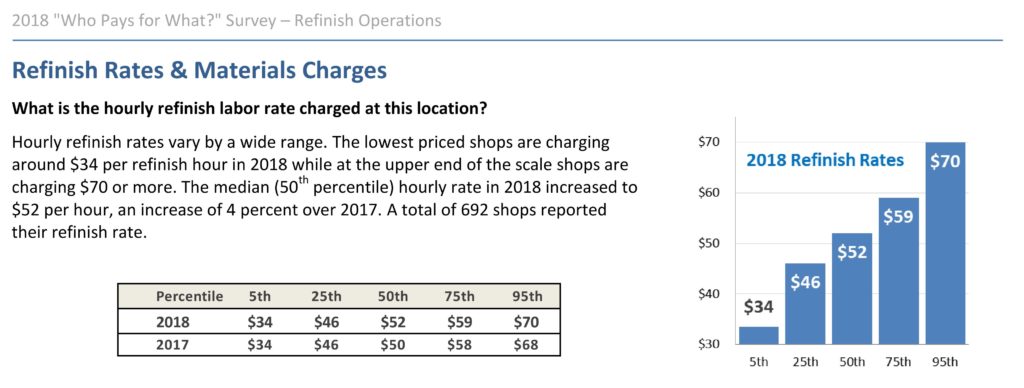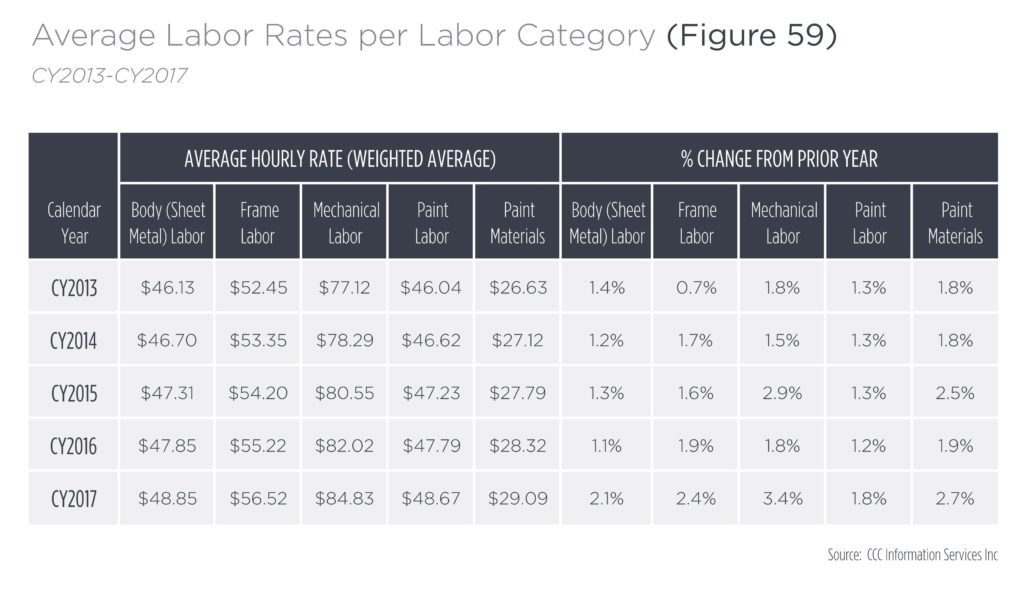
‘Who Pays?’, CCC, NABR offer estimates of U.S. paint labor rates
By onBusiness Practices | Market Trends
The past two months have seen the release of three auto paint labor rate data sets, and insurers and repairers might be interested in examining the various statistics.
The most recent came in Collision Advice and CRASH Network’s 2017 refinishing “Who Pays for What?” report, released earlier this month.
January polling of 692 auto body shops nationwide found a median rate of $52, up $2 from the $50 reported in 2016 and 2017 surveys. According to the Bureau of Labor Statistics, $50 in 2016 dollars translates to $52.31 today.
Fifth percentile and 25th percentile (the point at which 95 percent and 75 percent of shops charge more, respectively) rates held steady at $34 and $46, respectively — for a third straight year, according to the “Who Pays?” report. The 75th percentile rose $1 to $59 from the $58 it’d been the past two years — meaning 1 in 4 shops charge more, according to the studies.
The 95th percentile rebounded to the 2016 level of $70 after dropping to $68 in 2017.
2018’s report didn’t include the high and low rates of the data set; in 2016, it found refinish rates ranged from $26-$115.
Help the industry by taking the current “Who Pays for What?” survey on body labor operations here through April 30. All answers are kept confidential — data is published only in the aggregate — and participants receive a copy of the report. Collision Advance and CRASH Network encourage a shop to designate the person “most familiar with the shop’s billing practices and the payment practices of the largest national insurers” to complete the poll.
National AutoBody Research President Sam Valenzuela in early March reported an average “Body & Refinish” labor rate of $57 and a median rate of $52 from the approximately 4,650 shop door rates surveyed. He said shops generally charge the same for both labor categories.

Unlike other researchers who compare particular points in time, NABR’s data are rolling, meaning they are recalculated whenever a shop changes its rates or reports them for the first time.
Take the free Variable Rate Survey here.
Also in March, CCC reported in its annual “Crash Course” that its 2017 estimate data (which doesn’t distinguish between discounted direct repair program rates and door rates) found an average paint labor rate of $48.67, up more than $1 from 2016’s $47.79. The past five years of data indicate that like Valenzuela’s respondents, shops featured in CCC’s estimates are maintaining fairly similar body and paint rates.
The BLS reported that “Painters, Transportation Equipment” — the awkwardly named category into which everyone from boat painters to auto refinishers fall — made a median of $20.12 an hour and an average of $22.30 in May 2017. The BLS found industries like auto repair and auto dealerships paying painters $22.59 and $22.96 on average, respectively. (Unfortunately, it didn’t report medians for those subsets in such a convenient fashion.)
What a shop’s painters make in relation to its labor rate matters as a function of keeping the painters happy and keeping the shop afloat.
Valenzuela in a March guest column offered a hypothetical scenario of making 50 percent gross margin on labor, while automotive repair shop consultants Elite set a target of 70 percent. A CPA’s 2012 guest column in Auto Dealer Today also echoed the 70 percent figure.
Automotive News’ sister Fixed Ops Journal in October 2017 cited a National Automobile Dealers Association Academy recommendation that the service department have a 73 percent gross profit on labor.
It quoted David Shipp, service and parts director at Tafel Motor Co., whose Mercedes dealership offers three tiers of labor pricing:
His new three-tiered service rates haven’t hurt customer satisfaction, Shipp says, because price is not his main competitive advantage.
“The actual cost of the labor is secondary to the perceived value for the work done,” he says. “Customers attach a value to overall experience. We have to deliver a premium experience that is reflected in the overall costs.”
More information:
National AutoBody Research Variable Rate System survey results
Bureau of Labor Statistics May 2017 “Painters, Transportation Equipment” data
“How to Calculate Your Labor Gross Profit:”
Elite, tied to April 1, 2018, target
Images:
May 2017 Bureau of Labor Statistics data found industries like auto repair and auto dealerships paying painters $22.59 and $22.96 on average, respectively. (Alexeg84/iStock)
January polling of 692 auto body shops nationwide in the Collision Advice-CRASH Network “Who Pays for What?” survey found a median rate of $52, up $2 from the $50 reported in 2016 and 2017 surveys. According to the Bureau of Labor Statistics, $50 in 2016 dollars translates to $52.31 today. (Provided by CRASH Network and Collision Advice)
National AutoBody Research presented this chart of labor rate survey results from about 4,650 collision repairers nationwide. (Provided by National AutoBody Research)
The paint labor rate increased in 2017 to $48.67, up 1.8 percent and ahead of the 2.1 percent inflation rate, based on data from CCC estimates published in the 2018 “Crash Course.” (Provided by CCC)


